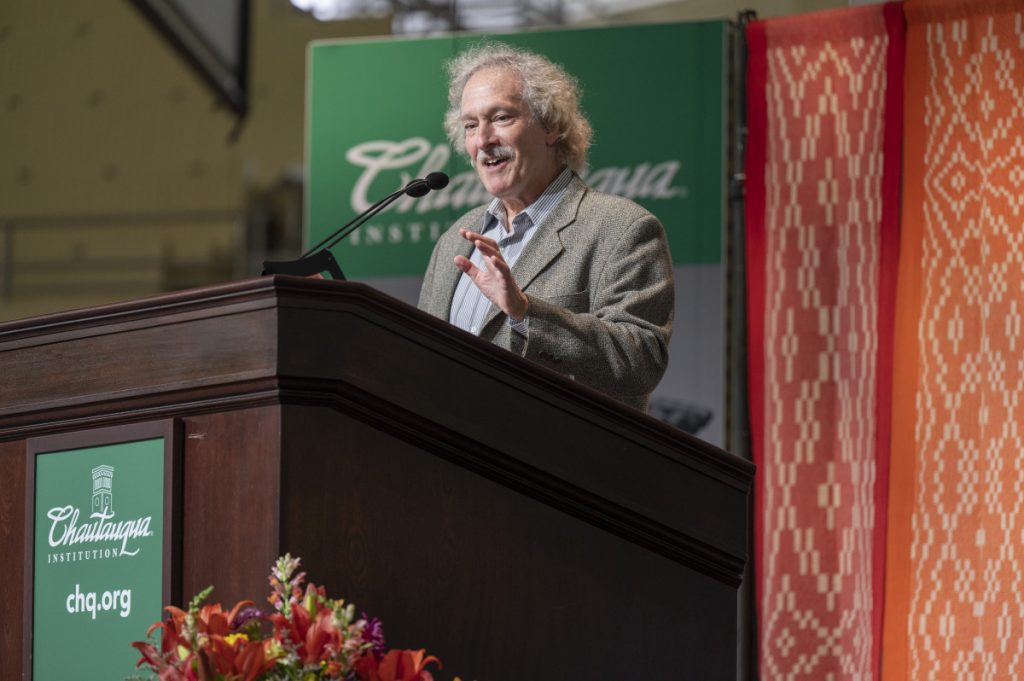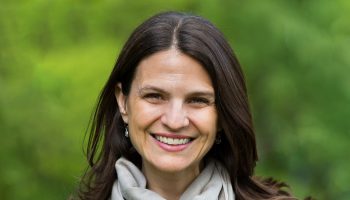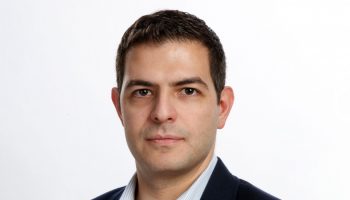MAX ZAMBRANO – STAFF WRITER

Georgetown University theology, art history, philosophy and political history professor Ori Z. Soltes took the Amphitheater stage on Aug. 16 to discuss the soul, one of his many areas of expertise.
Soltes, who has authored over 280 books, articles, exhibition catalogues and essay and served as Chautauqua theologian in 2007, opened Week Eight’s Interfaith Lecture Series, “The Human Soul: An Ineffable Mystery,” with his lecture titled “What Are We? Three Early Visions and Versions of the Soul,” though he added a fourth vision.
He reassured his audience, early and throughout, that the beginning of knowledge usually brings an awareness that one doesn’t know, which can be painful for some and invigorating for others.
Egypt
Ancient Egyptians’ concept of the soul is complex, with seven different parts that have overlapping traits, Soltes said.
The most common of these is the ba, or personality, which is depicted in Egyptian art as a bird hovering over the body that then moves on after death, he said.
“It decides, you decide — it’s in part dependent on how you live your life whether you will remain forever and ever thereafter in this other spiritual reality,” he said. “Or, you may decide, it may decide, circumstances may decide you come back in a newly incarnate form.”
Ironically, pharaohs did not have the same options as ordinary Egyptians because the pharaoh was understood as a god incarnate, he said. When the pharaoh died, the ba went to the successor and so on. Ordinary Egyptians, rather, may not come back again and move on to the other realm, he said.
The ba comes from a heaven called nut, he said.
“On the other side of many coffins, you have a depiction of nut as this kind of bluish, skyish being with four limbs in the four directions — east, west, north and south — and completely (covered) with myriad, myriad stars,” he said.
These stars weren’t just little dots, but individual and distinct to represent souls, he said.
“Likely, it is the individual souls who are the ancestral spirits of the one who is mummified within that coffin who is looking at eternity,” he said.
The ba is in union with the ka, which Soltes called the desire aspect of the soul and moral sensibility.
“It’s all animated by another aspect of the soul called khu, who I would render as divine spark,” he said.
The ba can be thought of as the heart, while the khu as the mind, he said. There is also the khaibit, a shadow aspect of the soul that stays between the gate of life and death, which the ba must pass by in order to reach nut or go back and reincarnate, he said.
When bodies were mummified in ancient Egypt, the lungs, stomach, intestines and liver were preserved in jars, but the heart was left inside the body, he said.
“The heart is understood to be so intimately connected to the body that it can’t be extracted,” he said. “If you extract it from that mummified body, somehow something would be amiss in what happens to the ba, which is an aspect of the soul which has a body connection.”
Genesis
Genesis 2:7 – “And God blessed the seventh day and made it holy, because on it he rested from all the work of creating that He had done. The Lord God formed the man from the dust of the ground and breathed into his nostrils the breath of life, and the man became a living being.”
Soltes opened his second section with reference to this passage. Prior to it, in Genesis 1:27, the creature, Adam, was said to be created in God’s image, he said. In Genesis 2:1, we know God created the universe in six days and rested on the seventh — a number deeply important to the Egyptians, Soltes said.
A difference exists — God is a singular being in Christianity, while Egypt’s story is much more complicated, he said.
The breath of life described in Genesis 2:7 is known as neshama in Hebrew, translating to soul or spirit. The ground, or earth, in Hebrew is called adamah, hence Adam. The Latin word for soul, anima, can be used to describe Adam as animated, or alive, he said.
Later in the Bible, though, comes the word nephesh, another translation of soul that Soltes said is similar to the Egyptian ba. The Bible also laters mentions ruah, or wind, which Soltes said could imply the breath.
The meaning of all this does not come from the Bible, but rather through interpretations of it, he said.
“In the understanding that evolved into Judaism, Christianity and Islam, this breathing, this neshama, breathed into this cloud of earth is understood to be a soul, which is understood to be a bit of God in all of us,” he said. “That’s what these traditions understand the soul to be.”
If God is immortal and imperishable, then so too are humans who have God within them, Soltes said about these faiths.
Another important aspect of the soul to these traditions is free will, he said. In the story of Adam and Eve eating the forbidden apple, Soltes described it as God telling Adam, before Eve was created, not to eat the apple. Adam then incorrectly interpreted this to Eve, telling her not to touch the apple.
“How could they disobey God’s command unless they had free will?” asked Soltes.
Free will was never considered in ancient Egypt, he said.
Greeks
When Odysseus, in The Odyssey, is at the edge of reality, he is able to open a passage between the living and the dead, Soltes said.
There, he is reunited with his deceased mother, and he tries to embrace her multiple times, unable to each time.
Greeks’ understanding of the soul is that something remains that looks like someone is alive, but there is no substance, he said.
Odysseus also meets Achilles, who he assumes must be having a great afterlife given all his praise during life.

“Achilles ruefully said, ‘I would rather be the poorest man on earth, a slave to someone (who) doesn’t own a stitch of property, than be king of all the underworld,’ ” Soltes said. “The Greek sense at that point of what it is that remains is something remaining in great discomfort. To have my bodily forms but not my bodily functions is a source of unhappiness.”
This perspective shifted with Socrates. Socrates was sentenced to death for impiety of the gods and corruption of the youth — essentially, he continuously asked questions that those in power were unable to answer, frustrating them, Soltes said.
Socrates was excited to die, though, because he believed the soul was immortal, Soltes said. Furthermore, he believed the soul was the better part of humans.
This is completely opposite to The Odyssey, in which the ghost of Achilles wished he had lived a much longer life.
“Socrates can’t wait to be deprived of the body, which he finds an impediment to what his soul has been doing his whole life — to which we infer by soul he means something like mind — because he’s been inquiring through his whole life what is truth, what is virtue, what is justice, what is love, what is friendship, what is good,” Soltes said.
In death, Socrates believed he would no longer be impeded by physical barriers like food, drink, sleep, sex or going to the bathroom, Soltes said.
When Plato was alive several hundred years later, he used Socrates as a mechanism for getting at issues old and new, Soltes said.
Three components of the soul are brought up here, from pure reason, or logos, to the opposite part of the soul, which is desire. In the middle is a component that deals with emotion and honor, he said.
“That middle state also mediates against doing crazy things that I have an appetite to do, or being robotic or being governed entirely by reason,” he said. “I think both Socrates and Plato very clearly understand that we are hardly a species governed by reason alone.”
Similar to these three components overlapping are the seven aspects that Egyptians believed in, though they are not the same, he said.
Greeks also believed that nobody was more powerful than fate. In The Iliad, Zeus, the most powerful Greek god, wants to save his son on the battlefield but knows that he cannot predict the outcome of his involvement, Soltes said.
“Even Zeus has to desist from what he would like to do because of fate,” he said. “The soul, with its tripartite understanding, is understood to be devised of elements of what is predetermined and what I am free willed to make happen for myself.”
Hinduism and Buddhism
In Eastern beliefs, there is a large understanding of the Brahma, or the first god in the Hindu triumvirate, Soltes said. Some groups are more familiar with other gods in Hinduism than others, from Vishnu to Shiva to Krishna, he said.
“If I am a Krishnite, I understand Krishna to be a constant avatar of being of Brahma, but I don’t disacknowledge all of the other manifestations,” he said. “It’s just they haven’t fully arrived as Krishna has.”
The text that describes that more succinctly is the Bhagavad Gita, or divine song, which he called a revealed text. In the Sanskrit language, this is Shruti, or that which is heard.
Yet it’s found in Mahabharata, an epic poem that is not heard, but Smriti, or that which is remembered, he said.
The content, he said, is a prince who has decided to go into battle to regain his throne, but then stops because he realized he was fighting against family, friends and neighbors, Soltes said.
Krisha gives wisdom to the prince, essentially saying if he killed his cousin he would not kill the soul, but instead the body, Soltes said.
“The truth is, the body is an illusion,” he said. “The body is what in Sanskrit is called maya. The reality of what is us is what’s called atman.”
The soul doesn’t die, but gets reincarnated in an ongoing cycle. If one does good things in one life, they will be reincarnated into a better life, and vice versa if one is bad, which is called karma.
When one ends up in a condition of nirvana, or spiritual perfection, they are released, which is called moksha.
“It’s like a droplet of water that is subsumed back in the sea of being,” he said. “Once that happens, you no longer can see that droplet of water. When I achieve that condition of nirvana, I who achieves it ceases to be an I.”
Buddhism is partly built on Hinduism, he said, but the personified God, names and concepts are not involved. Consequently, Soltes said Buddhism, in a sense, is not a religion.
“It’s not trying to tie me back to a God that is personified. … Buddha is not a God, it means enlightened,” he said. “But by having achieved enlightenment in the primary text of Buddhism, we understand he, in fact, transcends God.”
Buddha does not deny gods, but they are not where humans came from or are trying to return to; rather, it’s the sea of being, Soltes said.
What are we?
“We are what we as a species have come to believe ourselves to be, or perhaps what something other than ourselves has embedded in our consciousness,” Soltes said.
Humans have decided what we are over the course of our existence, based on egos, the brain, soul, heart, spirit, mind, God and gods.
“We cannot know, but it’s also part of our human essence to keep on trying to know,” Soltes said. “I don’t know if that’s part of our soul or something else, but it’s certainly an ongoing process — sometimes for better and sometimes for worse.”




